Creative Minds: Kouichi "Isuke" Yotsui
 Some videogame designers just punch a clock to earn a paycheck. Others are artists. It's clear from his discography that Kouichi Yotsui (四井浩一), AKA "Isuke" or "The Fourth Sally", falls firmly into the latter category. Even when working in a genre as ubiquitous as the head-to-head fighter, Isuke brought a freshness in approach and style that set his games apart from the rest. While he's not been the most prolific talent in the industry, his games have in many cases set the standard for others that follow.
Some videogame designers just punch a clock to earn a paycheck. Others are artists. It's clear from his discography that Kouichi Yotsui (四井浩一), AKA "Isuke" or "The Fourth Sally", falls firmly into the latter category. Even when working in a genre as ubiquitous as the head-to-head fighter, Isuke brought a freshness in approach and style that set his games apart from the rest. While he's not been the most prolific talent in the industry, his games have in many cases set the standard for others that follow.
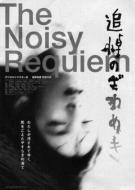 Isuke initially was a film student. He shot his own films and worked as one of the lighting technicians on the 1988 Japanese horror film The Noisy Requiem (追悼のざわめき). Set in the Kamagasaki neighborhood of Shin Sekai, Requiem features quite a lot of perversion and gore, including an incestuous midget couple and animal cruelty. The disturbing images are not gratuitous, but serve to illustrate a simple philosophical point: the lack of affection or affirmation from other human beings transforms individuals into cruel, selfish creatures. A line uttered by one of the characters early on reflects this: "Everybody turns into a crow when they're hungry." In graphically and adroitly illustrating this, Requiem struck a chord and became a modest underground success, with a diehard following that persists to this day.
Isuke initially was a film student. He shot his own films and worked as one of the lighting technicians on the 1988 Japanese horror film The Noisy Requiem (追悼のざわめき). Set in the Kamagasaki neighborhood of Shin Sekai, Requiem features quite a lot of perversion and gore, including an incestuous midget couple and animal cruelty. The disturbing images are not gratuitous, but serve to illustrate a simple philosophical point: the lack of affection or affirmation from other human beings transforms individuals into cruel, selfish creatures. A line uttered by one of the characters early on reflects this: "Everybody turns into a crow when they're hungry." In graphically and adroitly illustrating this, Requiem struck a chord and became a modest underground success, with a diehard following that persists to this day.
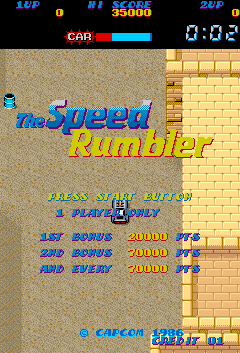 When Requiem wrapped, Isuke applied to work at Capcom. Unlike previous reports indicated, Strider was not Isuke's first game. That honor belongs to Capcom's 1986 game The Speed Rumbler, known in Japan as Rush & Crash (ラッシュ&クラッシュ). Speed Rumbler is a drive 'n' shoot game set in the 21st century. Mad Max and Spy Hunter had similar gameplay, but Isuke put a unique stamp on the genre by allowing the hero to exit his exploding vehicle and continue the battle on foot. And that hero was none other than... Super Joe. Though Super Joe first appeared in this Capcom game, it seems that Speed Rumbler's Super Joe is not the same as either the Commando or Bionic Commando character(s), and his presence does nothing to boost this game's name recognition. It also doesn't help that the game has a difficult learning curve.
When Requiem wrapped, Isuke applied to work at Capcom. Unlike previous reports indicated, Strider was not Isuke's first game. That honor belongs to Capcom's 1986 game The Speed Rumbler, known in Japan as Rush & Crash (ラッシュ&クラッシュ). Speed Rumbler is a drive 'n' shoot game set in the 21st century. Mad Max and Spy Hunter had similar gameplay, but Isuke put a unique stamp on the genre by allowing the hero to exit his exploding vehicle and continue the battle on foot. And that hero was none other than... Super Joe. Though Super Joe first appeared in this Capcom game, it seems that Speed Rumbler's Super Joe is not the same as either the Commando or Bionic Commando character(s), and his presence does nothing to boost this game's name recognition. It also doesn't help that the game has a difficult learning curve.
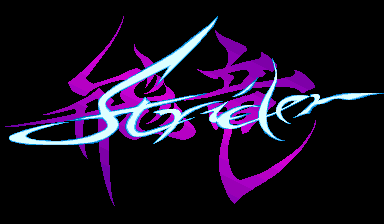 Soon afterward, Isuke was selected to work on another game, the one for which he is best known: Capcom's 1989 masterpiece Strider Hiryu. The LSCM exists because of this game and the rest of this site is dedicated to it, making a detailed examination unnecessary here. It's much more important to emphasize that, much like Oasis had with their album Definitely Maybe, Isuke managed to capture lightning in a bottle and craft a runaway hit. The pressure to follow it up must have been enormous.
Soon afterward, Isuke was selected to work on another game, the one for which he is best known: Capcom's 1989 masterpiece Strider Hiryu. The LSCM exists because of this game and the rest of this site is dedicated to it, making a detailed examination unnecessary here. It's much more important to emphasize that, much like Oasis had with their album Definitely Maybe, Isuke managed to capture lightning in a bottle and craft a runaway hit. The pressure to follow it up must have been enormous.
When an artist creates a hit of Strider's magnitude, two paths emerge. The first is the temptation to follow the template laid out by that hit, to see if it's a marketable formula. Publishers of all kinds urge their artists to follow this path, as they want to make money, and lots of it, and fast. If an artist follows this path, however, he will presently find his art diluted beyond repair. This is why Oasis suffered shipwreck three albums in and never recovered.
A true artist is unsatisfied with endlessly revisiting the same formula, choosing instead to follow another tributary, which often diverges wildly from the profitable course. Radiohead did this by following their fantastic third effort, OK Computer, with Kid A, a baffling left turn into cold electronica that was no less dense and layered... but not at all what their mainstream audience had wanted or expected.
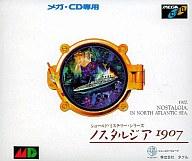 Isuke followed Radiohead's path. Instead of trying to bottle lightning a second time, he and two other Capcom employees (Akita Kitamura of Mega Man 1 & 2 and Shin'ichi Yoshimoto of Ghouls N' Ghosts fame, respectively) started their own publishing and development company, Takeru (タケル). The freedom that came with owning their own company allowed Isuke to develop an entirely different type of game from his previous blockbuster. Released in 1991, Isuke's third effort Nostalgia 1907 is a text-based adventure game set in the Edwardian "Age of Men". Kasuke Yamada, its protagonist, happens to be the only Japanese aboard the Nostalgia, a sumptuous cruise ship traveling through the north Atlantic. A bomb explosion cripples the ship's navigation, and a person identifying himself as the perpetrator sends a demand for something called the "Russian Mist", hidden on board. He threatens to detonate another bomb, sinking the ship and all on board, if the demand is unmet. Bomb fragments reveal it to be of Japanese manufacture, and naturally Kasuke becomes the prime suspect.
Isuke followed Radiohead's path. Instead of trying to bottle lightning a second time, he and two other Capcom employees (Akita Kitamura of Mega Man 1 & 2 and Shin'ichi Yoshimoto of Ghouls N' Ghosts fame, respectively) started their own publishing and development company, Takeru (タケル). The freedom that came with owning their own company allowed Isuke to develop an entirely different type of game from his previous blockbuster. Released in 1991, Isuke's third effort Nostalgia 1907 is a text-based adventure game set in the Edwardian "Age of Men". Kasuke Yamada, its protagonist, happens to be the only Japanese aboard the Nostalgia, a sumptuous cruise ship traveling through the north Atlantic. A bomb explosion cripples the ship's navigation, and a person identifying himself as the perpetrator sends a demand for something called the "Russian Mist", hidden on board. He threatens to detonate another bomb, sinking the ship and all on board, if the demand is unmet. Bomb fragments reveal it to be of Japanese manufacture, and naturally Kasuke becomes the prime suspect.

It is entirely in Japanese, was never translated into English, and most closely resembles Myst, if one had to select a more mainstream counterpart. Although it mostly sticks to the conventions of the genre, Nostalgia 1907 manages to distinguish itself by having multiple playable characters, through a thrilling bomb-defusing sequence Hideo Kojima cribbed for use in Policenauts, and in its sepia-tinged atmospherics that successfully impart an emotional connection to a bygone era.
After Nostalgia 1907's release, Isuke worked on another Takeru game called Presence (プレゼンス), before he and several others from Takeru departed for Mitchell Corp. Why Mitchell? Possibly because Capcom had acted as distributor for Mitchell's PANG! series in Japan (known in the US as Buster Bros.), and they had contacts there.
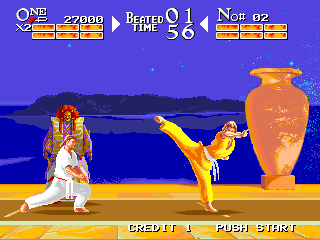 At any rate, at Mitchell Isuke made his fifth game, a head-to-head fighter meant to put Mitchell in the market that Capcom and Midway dominated at the time. Unlike Street Fighter and Mortal Kombat, 1992's The Karate Tournament eschewed superheroics in favor of grounded martial arts. More of a simulation than an actual game, its unassuming name revealed its gameplay. There are no fireballs. There are no dragon uppercuts. The combat is martial arts in its purest form. Players enter the tournament by choosing between a white, brown, or black belt to select the game's difficulty. Victory over an opponent does not result in advancement to the next belt, merely to a higher grade of the player's current belt. Only completion of the tournament awards a new belt, but it also ends the game.
At any rate, at Mitchell Isuke made his fifth game, a head-to-head fighter meant to put Mitchell in the market that Capcom and Midway dominated at the time. Unlike Street Fighter and Mortal Kombat, 1992's The Karate Tournament eschewed superheroics in favor of grounded martial arts. More of a simulation than an actual game, its unassuming name revealed its gameplay. There are no fireballs. There are no dragon uppercuts. The combat is martial arts in its purest form. Players enter the tournament by choosing between a white, brown, or black belt to select the game's difficulty. Victory over an opponent does not result in advancement to the next belt, merely to a higher grade of the player's current belt. Only completion of the tournament awards a new belt, but it also ends the game.
The Karate Tournament is notable for one more thing: its graphics "morph" to indicate speed of movement. This contrasts with the Capcom way of doing things, where the motion blur is actually drawn into the sprite itself. Here, the sprite-distorting morphing occurred within the game engine.
 Despite its innovations, the game was unsuccessful and barely made it Stateside. So Isuke and its object designer, Utata Kiyoshi (転清), began work on another. It took four years, but 1996's Osman ended up being everything The Karate Tournament had not: flashy, loud, full of superheroics and explosions grandiose enough to make Michael Bay green with envy. It drew much of its attitude and approach from Isuke's blockbuster, revisiting many of the same tropes put to use in Strider while updating them with fresh twists. In many respects it was the sequel fans had been clamoring for, though it lacked Hiryu himself. It certainly satisfied in ways that Strider Returns never could.
Despite its innovations, the game was unsuccessful and barely made it Stateside. So Isuke and its object designer, Utata Kiyoshi (転清), began work on another. It took four years, but 1996's Osman ended up being everything The Karate Tournament had not: flashy, loud, full of superheroics and explosions grandiose enough to make Michael Bay green with envy. It drew much of its attitude and approach from Isuke's blockbuster, revisiting many of the same tropes put to use in Strider while updating them with fresh twists. In many respects it was the sequel fans had been clamoring for, though it lacked Hiryu himself. It certainly satisfied in ways that Strider Returns never could.
The sad thing is, Osman also failed to do well. That may have had something to do with its old-school aesthetics in a time when arcades as a whole were on the decline, but regardless, Isuke wound up leaving Mitchell. Of the time that Isuke had spent at Mitchell, Roy Ozaki had this to say:
CHZ: One memorable aspect of Cannon Dancer is its similarity to Capcom's Strider Hiryu. Strider Hiryu and Cannon Dancer had the same game designer, Isuke. Were other ex-people from Capcom working on the game?
OZA: You know that game people move around. We had some Capcom misfits in the past.
Ozaki's comments are probably not directed at Isuke personally. More likely, he was referring to the whole batch of ex-Capcom people that had come to Mitchell from Takeru. Still, his comments seem to indicate that the parting was less than amicable.
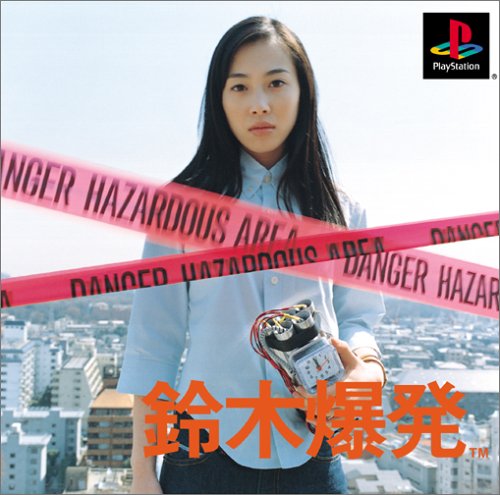 After Mitchell, there are unsubstantiated rumors that Isuke went back to Capcom and began work on Strider 2, only to leave when they insisted on developing it for PlayStation hardware instead of CPS-3. By one route or another, he found himself at Enix. There he developed Suzuki Explosion, whose female protagonist Suzuki had the misfortune of regularly encountering bombs that looked like ordinary everyday items. The player must use clues found within the game to disarm these explosives in the time alotted. The graphics were mostly still photographs of commonplace situations and objects. It was entirely in Japanese and was not a noir or detective game, setting it apart from any comparisons to Nostalgia 1907. Though it debuted at 11th place on the Japanese charts, its idiosyncricity and thoroughly bizarre approach was off-putting and it never made it to the US. Not even a roundtable discussion in Studio Voice prevented it from dropping from public view.
After Mitchell, there are unsubstantiated rumors that Isuke went back to Capcom and began work on Strider 2, only to leave when they insisted on developing it for PlayStation hardware instead of CPS-3. By one route or another, he found himself at Enix. There he developed Suzuki Explosion, whose female protagonist Suzuki had the misfortune of regularly encountering bombs that looked like ordinary everyday items. The player must use clues found within the game to disarm these explosives in the time alotted. The graphics were mostly still photographs of commonplace situations and objects. It was entirely in Japanese and was not a noir or detective game, setting it apart from any comparisons to Nostalgia 1907. Though it debuted at 11th place on the Japanese charts, its idiosyncricity and thoroughly bizarre approach was off-putting and it never made it to the US. Not even a roundtable discussion in Studio Voice prevented it from dropping from public view.
Its creator followed it. Isuke retreated from the limelight, working as a planning assistant on the PS2 RPG Drakengard 2 and on the scenario for the Nintendo DS game Otoshi Deka. He hasn't made a game of his own since Suzuki Explosion, which, ultimately, is a shame. He recently surfaced to give an interview to Gameside Magazine (the Japanese counterpart to Retro Gamer), though, so... perhaps we here in the States will see him again soon.
Looking back at Kouichi Yotsui's career, one sees the work of a restlessly creative mind, concerned more with following its muse than the pursuit of money. The games he produced rank among the most inventive in the industry, and despite their commercial failure are works of art in their own right. Were more game creators like him, there's no doubt that the industry itself would be healthier today.
Isuke's Gameography
| JAPANESE TITLE | ENGLISH TITLE | SYSTEM(S) | YEAR | PUBLISHER |
|---|---|---|---|---|
| ストライダー飛竜 | Strider | CPS-1 | 1989 | Capcom |
| ノスタルジア1907 | Nostalgia 1907 | X68000 | 1991 | Sur Dé Wave |
| チャタンヤラクーシャンク | The Karate Tournament | ??? | 1992 | Mitchell Corp. |
| 燃えよゴンタ‼ | Lady Killer | ??? | 1993 | Mitchell Corp. |
| キャノンダンサー | Osman | Data East 156 | 1996 | Mitchell Corp. |
| 鈴木爆発 | Suzuki Explosion | Sony PS | 2000 | Enix |
| ムーンダイバー | Moon Diver | PSN/XBLA | 2011 | Square-Enix |
Work-For-Hire
| JAPANESE TITLE | ENGLISH TITLE | SYSTEM(S) | YEAR | PUBLISHER |
|---|---|---|---|---|
| ラッシュ&クラッシュ | The Speed Rumbler | ??? | 1986 | Capcom |
| トップシークレット | Bionic Commando | ??? | 1987 | Capcom |
| 大魔界村 | Ghouls 'n Ghosts | ??? | 1987 | Capcom |
| プレゼンス | Presence | FM-Towns | 1992 | Sur Dé Wave |
| サブマリンハンター 鯱 | Submarine Hunter Shachi | Sony PS | 1999 | Victor |
| ドラッグオンドラグーン2 封印の紅、背徳の黒 | Drakengard 2 | Sony PS2 | 2005 | Square Enix, Ubisoft |
| 落シ刑事(デカ)~刑事さん、私がやりました~ | Otoshi Deka: Keiji-san, Watashi ga Yarimashita | Nintendo DS | 2008 | Beyond Interactive |
Sources
- "The Speed Rumbler for Arcade Games". Gamespot.
- Matsui, Yoshihiko (Director). 1988. 追悼のざわめき (The Noisy Requiem). Japan: Yokubou. B/W. 150 mins.
- CRV. "Company:Takeru". Game Developer Research Institute. 21 Aug 2009.
- Kohama, Dai. "Nostalgia 1907". Play Magazine Online. 26 Mar 2006.
- "アーケードゲーム (p. 2)". Mitchell Corp. 2006.
- Bousegis, Alexis. "chatan yarakuu shanku - the karate tournament video game, mitchell (1992)". Arcade-History.com. 4 Apr 2008.
- TKY. "キャノンダンサー 攻略". TKY's Home Page. 19 Aug 2008.
- Seydoux, Chaz. "shokkingu hitofude". Insert Credit. 16 Jan 2006.
- Nekoboy-AMN. "Next-gen STRIDER - when are we gonna get one?" p. 1, #9. Kombo Forums. 01 May 2006.
- "2000 ~ 1996". Square Enix.
- IGN Staff. "Japanese and North American Sales Figures: 7/02 - 7/09". IGN. 14 Jul 2000.
- 阿見寛. "[鈴木爆発]座談会 内藤啓介×小野英作×田中知之×四井浩一/ [鈴木爆発]". Studio Voice Vol. 296 (Aug 2000). 6 Jul 2000.
- "Drag-On Dragoon 2: Fûin no kurenai, haitoku no kuro (2005) (VG) - Full cast and crew". IMDB.
- "落し刑事(デカ)~刑事さん私がやりました~特設ページ". Beyond Interactive. 18 Sep 2008.
- "ゲーム業界を"爆発"させた"ストライダー"の父 「四井浩一」ディスコグラフィー". Gameside Vol. 16 (Feb 2009). 3 Jan 2009.